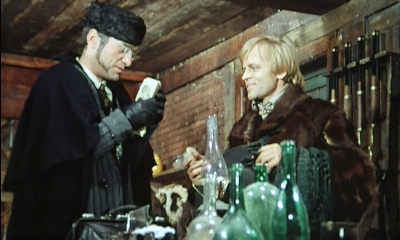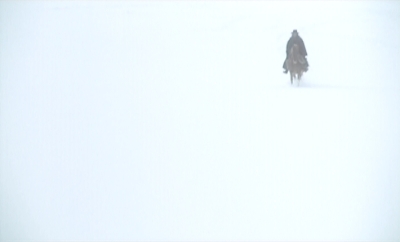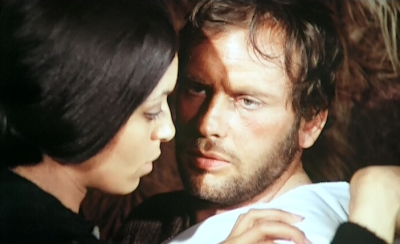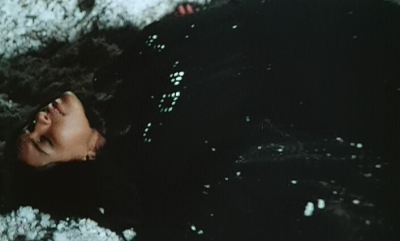Turning the Western on its head: Simple subversion in Sergio Corbucci’s The Great Silence (1968)

It could claim to be the most subversive denouement in the history of narrative cinema. The ending of Sergio Corbucci’s Italian Western The Great Silence (1968) sees not only the film’s hero gunned down, having failed to save the day, but also features the massacre of every other sympathetic or victimised character in the film. Upon deeper examination there are several factors that contribute to its subversive stance. Corbucci was a director of several Spaghetti Westerns containing left wing and radical politics as either the subject or subtext. The Italian Western itself was seen as a subversion of a unique American art form. This was mainly down to what Frayling (2006) calls the ‘Cultural Roots’ controversy, the initial criticism faced by Westerns of Italian origin that they ‘had no ‘cultural roots’ in American history or folklore, they were likely to be cheap, opportunistic imitations’ (Frayling, 2006 p,121). Another significant factor that may explain the film’s subversive tone was its timing. The film was released in 1968, and contains an explicit, though not terribly in depth, criticism of capitalism, an interracial sex scene, and has a downbeat, pessimistic ending, all of which are in keeping with the counter cultural zeitgeist of the late 1960’s. While each of these factors contributes, it is the ending that marks the film as a truly subversive work of cinema.
The Great Silence is not as overtly political as some of Corbucci’s other westerns. His films A Professional Gun (1968) and Companeros (1970) belong to a sub genre of political Spaghetti Westerns, alongside films such as A Bullet for the General (Damiano Damiani, 1966), The Big Gundown (Sergio Sollima, 1966) and Face to Face (Sergio Sollima, 1967). Sergio Leone contributed his own political Spaghetti Western with A Fistful of Dynamite (1972). These films dealt with explicit political and revolutionary themes, often set during the Mexican revolution. The basic narrative of each film was that of an American or European being educated in the ways of third world revolution by a bandit or revolutionary figure:
the Westerns in this sub genre were intended to be read as parables about the relations between the Third World (represented by Mexico) and the capitalist countries of the West (represented by the outsider). (Frayling, 2006, p232).
The political Spaghetti Westerns typically extolled simplistic revolutionary Marxist politics, while occasionally referencing anarchism via crudely drawn ‘anarchic’ characters or unsubtle references to Bakunin. Porton (1999) highlights the bandit character of Juan in Leone’s film and the way the ‘Outsider’ character shows contempt for this ‘anarchism’ by throwing away his book of Bakunin’s writings as examples of this.

Ruthless killer Kinski (right) with great character actor Luigi Pistilli
While the narrative of The Great Silence does not concern revolution, it contains in its basic plot a number of critiques of capitalism and on the whole works as a subversion of what Will Wright describes as the ‘The Classical Plot’ of the western.
The Classical Plot is the prototype of all Westerns, the one people think of when they say, ‘‘All Westerns are alike’’. It is the story of the lone stranger who rides into a troubled town and cleans it up, winning the respect of the townsfolk and the love of the schoolmarm.’ (Wright, p32, 1975)
Wright cites Shane (George Stevens, 1953) and Dodge City (Michael Curtiz, 1939) as two examples of this model. With such a standard, familiar plot, and with such recognisable iconography, the Western is ripe for subversion. From within the industrial context of Hollywood Johnny Guitar (Nicholas Ray, 1954) is an excellent example of a film which takes some of these elements and twists them into something unusual. In Johnny Guitar it is the foregrounding of the female characters and the overall passivity of the male characters which subverts some of the ideology of the traditional Western. The Great Silence lays out its narrative in a relatively straightforward way. The hero, a mute gunfighter called Silence, arrives in a town called Snow Hill and is hired by a local woman to kill the bounty hunters who have shot and killed her husband. The bounty hunters have been hired by Policutt, the local banker, to kill former townspeople who have been forced from their homes and have to steal to survive. Corbucci’s criticism of capitalism here is explicit. The townspeople have been declared criminals by the state, and the hunting of them is protected by law. However, the townspeople are only outlaws due to the policies of the state and its protection of property over people. Thus the narrative is set up for Silence to kill the villainous capitalists and liberate the town. However, each aspect of the film in some way deviates from most standard Western texts, whether American or Italian. The location is not the traditional Western landscape, it is set in the snow, rather than the desert or plains. The bleakness of the winter landscape complements the bleakness and pessimism of the tone of the film, foreshadowing the ending of Altman’s McCabe & Mrs. Miller (1971). It also provides further motivation for the characters, and the living conditions and chances of survival for the outlawed townspeople is made much harder as a result. In his book 10,000 Ways to Die: A Directors Take on the Spaghetti Western, Alex Cox notes that “many shots are filtered by smoke, or falling snow, or windows. Indeed, there are so many rippling images through glass that the film at times resembles a ship inside a bottle, or a snowscene –fair metaphors for the enclosed, cruel world herein displayed” (Cox, 2009, p187). In this sense the backdrop of snow isolates the events of the story by providing very little other visible geographical detail. While it would be a stretch to say that this gives the film a fairytale element, it does divorce it from being part of the recognisable world of the Western. The film takes place in its own world, rather than part of the American Frontier.

Adrift in the snow. Silence makes his Shane-like intro
Silence shares superficial characteristics with other heroes from Spaghetti Westerns: he is dressed in black, has superhuman accuracy with a firearm, and is anti heroic, sharing some of his characteristics with the villains. For example his price for hire is the same as that of the chief bounty hunter Tigero. Hero and villain sharing similar traits is also clearly visible in Leone’s movies, where the dualism of Leone’s heroes and villains is a recurrent motif. Corbucci’s Django and Leone’s The Man with No Name are quiet characters, typically ‘strong and silent’ types, but Silence is actually a mute, as a result of his throat being cut by Policutt as a child. Being unable to express himself verbally gives him an unusual vulnerability and sensitivity. It is not because he is tough that he does not scream in pain when tortured at one point, but because he cannot. His ‘exceptional ability’ is that he is extremely fast and accurate with a gun. However, even this factor deviates from the iconography of a standard Western. His gun is a semi automatic Mauser rather than a revolver. His accuracy with it is incredible, but the gun’s more rapid rate of fire gives him an unfair advantage over his opponents, who are using the standard single action revolvers familiar from most Westerns. His ‘exceptional ability’ in this case is more as a result of technology than any physical prowess. The hero with special, unique equipment is familiar from many genres, and was a vital component of sixties action cinema, with the James Bond franchise leading the way. It is also, of course, present in Propp’s narrative functions, the hero’s use of a ‘Magical Agent’. The key Spaghetti Western reference for the hero with special equipment is Gianfranco Parolini’s ‘Sabata’ trilogy, Sabata (1969), Adios, Sabata (1971), and Return of Sabata (1971). Sabata has an array of unique firearms to mark him as special and give him advantage over the villains. But for Silence this ‘exceptional ability’ and special equipment does not save him. After Silence has been killed Tigero removes the Mauser from his corpse and takes it for himself, delivering a symbolic castration upon the hero. The hero is not only defeated but also defiled. This is not the only indignity suffered by Silence. His shooting hand is held in a fire just prior to the climax, injuring him sufficiently so that he cannot defend himself adequately at the final showdown. The destruction of the hero’s hands is significant. In the very first scene Silence shoots the thumbs off a bounty hunter so that he is unable to be able to fire a gun again. He also shoots off Policutt’s thumb. Silence is a killer for hire like the bounty hunters, and both use similar torture techniques, thus the link between them is established.
In the American Western the action takes place across a number of homosocial spaces, the saloon, the range, amongst cavalry units and such like. But there is often a home, run by women, to come back to, as a refuge or reward. The concept of the family, even if it is temporarily torn apart in film such as The Searchers (John Ford, 1956), remains fundamentally in place. In the Italian Western this is not the case. The home and family is seen as a weak unit, vulnerable to the whims and desires of bad men. The massacres of the families that take place near the start of Leone’s The Good, the Bad, and the Ugly (1966) and Once Upon a Time in the West (1968) serve to show us the ruthlessness of the chief villains and the power of the gun, money and business over that of the family. The regular invasion of the home in the Spaghetti Western and the relative lack of female characters, means the entire screen space becomes homosocial.
Spaghetti Westerns were, with one or two exceptions, a celebration of the masculine world where men were men and women – on the rare occasions they appeared – seemed to like it that way: the understated masculinity of the classic Hollywood Western (which belonged to the same world, only less so) had turned into in your face close ups of rugged faces, twitching hands and fetishized weaponry, maleness as spectacle and style, and sometimes into extraordinary feats of athleticism and grace. The audience stared at the protagonists staring at each other. The women were usually, as the cliché goes, madonnas or whores and sometimes both at once. The politics of the Spaghetti Western, which could be quite radical, did not extend very far into sexual politics’. (Frayling, 2006, p. XVI)
However, the lead female character of Pauline in The Great Silence is more proactive and displays more power than is usual in an Italian Western. She seeks vengeance for the death of her husband through Silence, and dies by his side at the end when she attempts to use the dead Silence’s gun to kill Tigero. Her actions in this case propel the narrative. She also has two interesting scenes with Policutt where she demonstrates a control over her own body and sexuality which is unusual for this type of film. First, she turns down his offer of sex for $1000, instead willingly offering herself to Silence. That her and Silence later share a sex scene and fall in love implies this is because she finds him more attractive than Policutt. Pauline is also the one who seduces Silence, rather than the other way round, and because he is unable to verbally consent to her advances, she has to physically make a move on him. Later in the film she avoids being raped by Policutt. This is with Silence’s help, but the fight she puts up again shows a higher level of autonomy over her body than most female characters in American or Spaghetti Westerns. In this sense she is neither ‘madonna’ nor ‘whore’. Her character exists as a vital part of the narrative, rather than providing a shorthand image of ‘goodness’, as a ‘madonna’ type character would, or as a ‘whore’ type character, which typically exists to provide visual pleasure, and to give the hero someone to save. Pauline is also black, which adds another subversive twist to the film. Black characters have been historically underrepresented in Westerns and sex scenes between white and black actors are still a rarity in commercial cinema. It allows Corbucci to make the character of Tigero more villainous by making him a racist. After he has been paid to kill Pauline’s (black) husband he comments ‘What times we live in, when a black man is worth as much as a white man’.

The pessimistic ending of The Great Silence is the culmination of all these subversive tweaks to the traditional Western codes and conventions. The death of the hero is in itself not that unusual, certainly not in the late 1960’s. In the same year the African American hero of Night of the Living Dead (George A. Romero, 1968) is shot and killed. The death is presented in a matter of fact way and the corpse of the hero is then slung on a bonfire. As in Corbucci’s film the hero not only dies but suffers indignity. In Easy Rider (Dennis Hopper, 1969) the two heroes are also murdered at the film’s climax. The key difference is that the heroes are killed by similarly disenfranchised groups, in these cases reactionary, Redneck characters. In their own way they are as much outsiders from mainstream American society as the leads. They stand in ideological opposition to the lead characters – blacks, zombies, hippies – but, as Southerners, are also traditionally in opposition to the central, or union, American government. The villains who kill Silence and Pauline, and who then turn their guns on the outlawed townspeople, leaving none alive, are working as part of the establishment. They are not the law, but they are in the service of capital by helping to protecting it. By the films’ end capitalism is shown as a crushing force, more powerful than the interests of the public. Ken Russell’s The Devils (1971) is one of the few films that comes close to sharing a similar, inevitably bleak conclusion where the good characters are powerless against the unstoppable, evil establishment. However, what makes Corbucci’s film more subversive than The Devils, and more so than Romero and Hopper’s films, is that it is part of a far more established, conventional genre. Night of the Living Dead, Easy Rider and The Devils may be original, subversive, and idiosyncratic films, but were all made without the restrictions of well established genre conventions. Unlike these films The Great Silence not only contains material that is oppositional and anti authoritarian, but also subverts and comments on the very genre that it is part of.

The film’s downbeat ending
The film’s simple politics (Cox 2009), made as part of an action film, lead to the inevitable debate about what it means to make films within the system it criticises. Frayling outlines the argument made by Cahiers du Cinema critic Pierre Baudry that;
A colonial ideology is being used to ‘criticise’ a colonial reality – a dangerous game to play – and, in the process, all we get is a repetition of nineteenth – century stereotypes (the dignified poor versus the immoral rich). (Frayling, 2006, p. 228,)
This is in relation to the more explicit political Spaghetti Westerns of Corbucci, Sollima, and Damiani, but this argument could also apply to The Great Silence or to any film made by a significant studio that criticises the capitalist institution which either makes or distributes it. Staig and Williams counter this by claiming that “the motifs of the political Western can get the message across to a mass audience better than any Le Vent d’Est of a Jean Luc Godard” (1975, p. 92,). This is a persuasive argument, going against the Godard/Dziga Vertov groups’ concept that it is important to make films politically, rather than just make political films. The politics of these films also contradict the claim made by Sterritt (1999) that Le Vent d’Est (1970) (which stars Spaghetti Western icon and self-proclaimed Communist, Gian Maria Volonté) was ‘cinema’s first Marxist western’ (1999, p. 130). However, while exempting Corbucci, Sollima and Damiani from criticism, they are also of the opinion that “in many cases the political Western was just another gimmick employed by directors to add a new novelty to their films” (1975, p.92). They go on to make the point that these films appear to be addressing politics that have little relation to the real West that the films are aiming to represent. This is a flawed argument however, because many films use the trapping of genre (the setting, locations, iconography) to spin a narrative that is allegorical. In the Science Fiction genre this is standard, just in reverse, where representations of the future may be used to comment on the present. But this is not necessarily how The Great Silence works. It does not have to be read as politically allegorical. It is a subversive film that uses the narrative conventions and iconography of the genre (drawing heavily on the ‘Classical Plot’) to criticise and comment on the conventions of the genre itself. And rather than being allegorical, it is a targeted attack on capitalism and other reactionary politics, in keeping with the mood of the times it was made.
BIBLIOGRAPHY
Cox, A. (2009) 10,000 Ways To Die: A Director’s Take on the Spaghetti Western. Kamera Books.
Frayling, C. (2006) Spaghetti Westerns: Cowboys and Europeans from Karl May to Sergio Leone. 2006 edition, I.B. Tauris & Co.
Porton, R. (1999) Film and the Anarchist Imagination. London. Verso Books
Staig, L and Williams, T. (1975) Italian Western: The Opera of Violence. London. Lorrimer Publishing Ltd
Sterritt, D. (1999) The Films of Jean Luc Godard: Seeing the Invisible. Cambridge. Cambridge University Press
Wright, W. (1975) Sixguns and Society: A Structural Study of the Western. London.University of California Press, Ltd.














